A solar panel is made up of solar cells that convert solar energy (sunlight) to electricity. This conversion is known as photovoltaic effect. Solar energy is the best alternate energy source as it is renewable, easy to produce and saves the environment. The government of India too promotes it by providing remarkable subsidies.
Basic structure of a solar cell and its working principle
A solar cell, also known as a photovoltaic cell, works on the principle of photoelectric effect—ability of an object to emit electrons when light falls on it. To generate electricity from a solar cell, a material is required that emits electrons and is raised to a higher energy state by the absorption of light. These electrons have enough energy to drive the connected device or load. The cells are made of a semiconductor material that is used in the form of p-n junctions.
A solar cell consists of n-type (having electrons as a majority charge carrier) and p-type (having holes as a majority charge carrier) semiconductor materials. The depletion region is formed between n-type and p-type materials. The depletion layer is made up of positive and negative ions. Electrons and holes are not present inside the depletion layer. Light travels in the form of packets of energy called photons. These photons (sunlight) are applied on the depletion region.
Photons are absorbed in depletion regions and generate electron-hole pairs. These free electrons and holes have enough energy to jump out of the depletion zone. If a wire is connected from the cathode (n-type material) to the anode (p-type material), electrons flow through the wire. The electrons have negative charge and, hence, get attracted by p-type material (positive terminal), travel through the external load (device) and create a flow of electrons (current), as shown in Fig. 1.
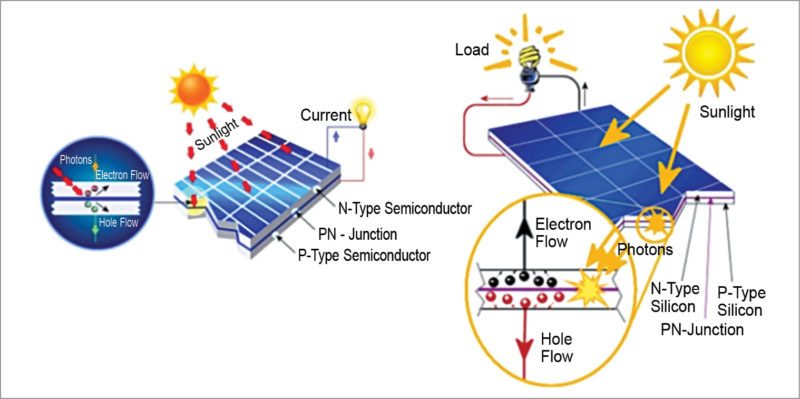
As shown in Fig. 2, the sunlight concentrator focuses sunlight on a small part and tracks the Sun throughout the day for higher efficiency. The solar panel generates unstable or fluctuating electricity and, thus, has to be regulated. The power-conditioning block gives regulated stable electricity that is stored in the battery or a battery bank. The battery gets damaged if a proper power-conditioning circuit is not used. The device gets energy from the battery.
Sometimes, a solid copper foundation is laid over the solar panel that gives it massive strength. Solar panels may have anti-reflective (AR) coating over the surface to produce more energy and increase efficiency. AR layer usually has NaOH surface texturation with several tiny pyramids. The layer’s thickness should be designed for better efficiency.
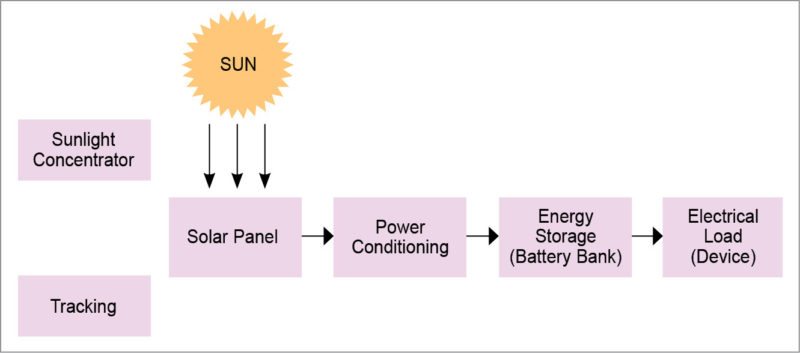
Multi-junction structure of a solar cell
A few years ago, late Dr A.P.J. Abdul Kalam said that we are not utilising solar energy efficiently. Researchers are working hard and have come up with different solar structures and technologies to increase the efficiency of solar cells. Till now, we have depended on single-junction solar cells that give an efficiency of about 20 per cent. To improve this efficiency, the concept of multi-junction solar cells has been adopted. These are solar cells with multiple p-n junctions made up of different semiconductor materials.
The gap between valance band and conduction band is called forbidden gap or energy gap (Eg). In an energy band diagram, electrons jump from valence to conduction band and become free when electrons absorb enough energy. These electrons are considered free electrons and take part in current flow. If an applied photon has wavelength greater than or equal to hc/Eg (h is Plank’s constant and c is velocity of light), electrons gain enough energy and jump from valence to conduction band.
Electrons that belong to conduction band take part in current flow and are thus responsible for generating electricity. In the above-mentioned relationship, h and c are constant, which means the number of free electrons depends on Eg. This Physics fundamental has been used in the structure of solar cells. A multi-junction structure (material with different values of Eg) absorbs maximum sunlight (broad range of wavelengths), generates more free electrons or current and, ultimately, increases the efficiency of solar cells.
The top-most junction has the widest band gap and, as we go down, it decreases. It is necessary to find the best semiconductor materials in terms of band gap to increase efficiency. Fig. 3 shows the different semiconductor materials used in a multi-junction solar cell. As photons (sunlight) strike the solar cell, highest energy-level photons are absorbed by the top-most layer, and photons with low energy are absorbed in the lower layers.
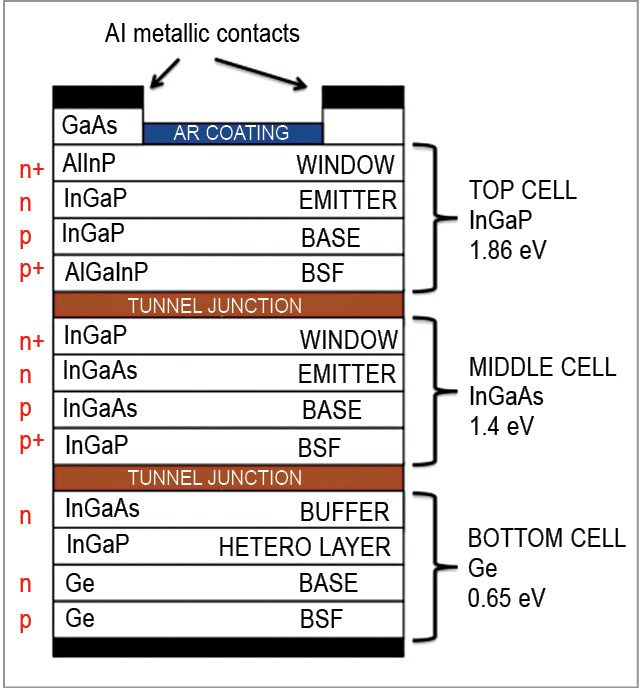
A window layer is used to reduce surface recombination velocity, and the back surface field (BSF) layer reduces the scattering of carriers towards the tunnel junction. It simply functions as an electrical contact and, thus, covers the entire back surface of the cell structure. It is always made of metal.
Researchers of the University of New South Wales, Australia, have developed a mini-module that combines a silicon cell on one face of a glass prism, with a triple-junction (TJ) solar cell on the other, as shown in Fig. 4. This research has achieved the world record for the highest efficiency, which is approximately 34.5 per cent. This novel model was also tested and confirmed by US National Renewable Energy Laboratory.
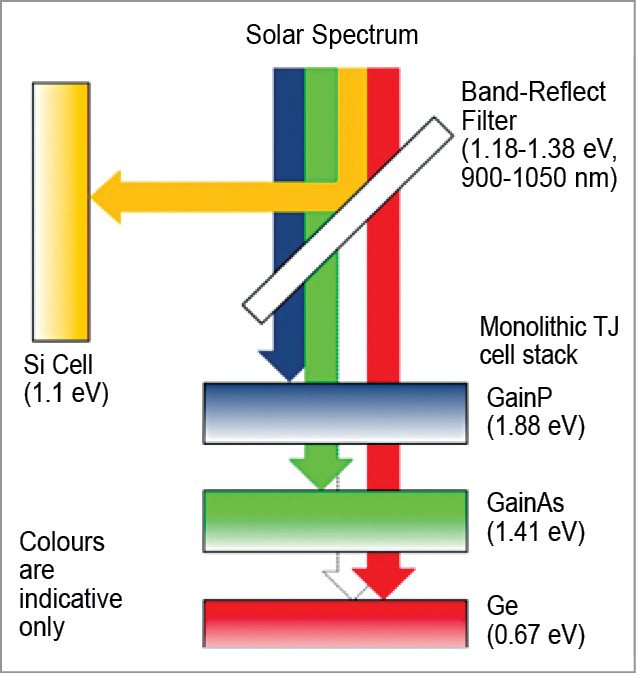
The triple-junction cell targets discrete bands of incoming sunlight using a combination of three layers. As sunlight passes through each layer, energy is extracted by each junction at its most efficient wavelength, while the unused part of the light passes through to the next layer, and so on. Apart from the prism structure, logic remains the same as of a multi-junction solar cell.
Efficiency of a solar cell
Efficiency of a solar cell can be represented in many ways, namely, thermodynamic, charge carrier separation, quantum and conductance. Several factors and parameters are difficult to measure directly and, hence, other parameters are measured to calculate quantum efficiency.
Quantum efficiency can be measured in terms of internal quantum efficiency (IQE) and external quantum efficiency (EQE). IQE is the ratio of the number of charge carriers (free electrons and holes) collected by the solar cell to the number of photons of given energy that shine on the solar cell from outside and are absorbed by the cell.
EQE is the ratio of the number of charge carriers collected by the solar cell to the number of photons of given energy shining on the solar cell from outside (incident photons). IQE is always greater than EQE. Efficiency of a traditional solar cell can be in the range of 14 to 24 per cent.
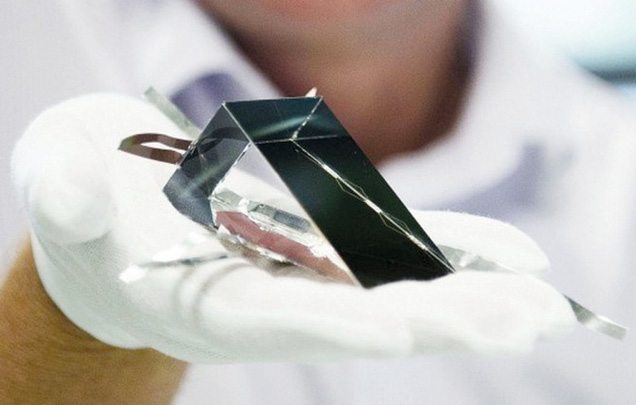
A solar panel (that converts sunlight to electric energy) and a thermal panel (that converts sunlight to heat energy used to produce hot water) are completely different. The latter is designed with an efficiency of up to 90 per cent.
Efficiency of a solar cell also depends on parameters like area of the cell, intensity of sunlight, wavelength of the photons, ambient temperature and so on.
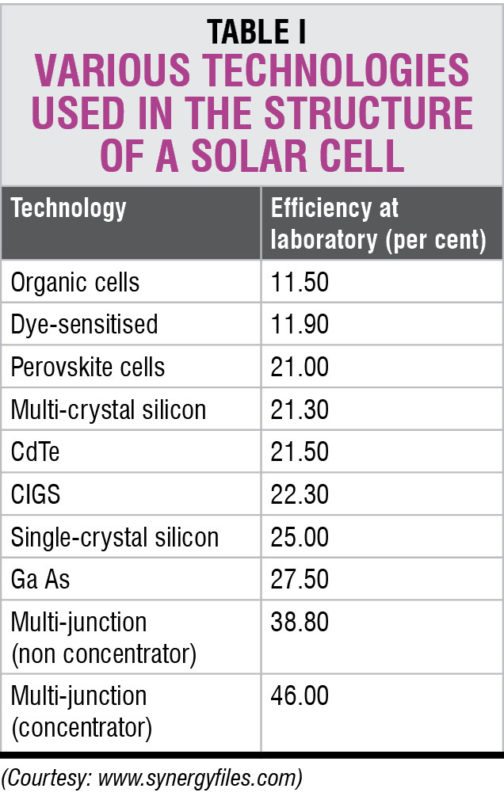
Typically, efficiency is represented as energy at output/area of cell/time; for instance, 4.5 kWh/m2/day. This means that a solar panel of 1m2 size generates 4.5kWh electric energy per day. It may be more or less depending on environmental conditions. Tables I and II give show the different technologies used to make solar cells, models, types, manufacturers and efficiencies.
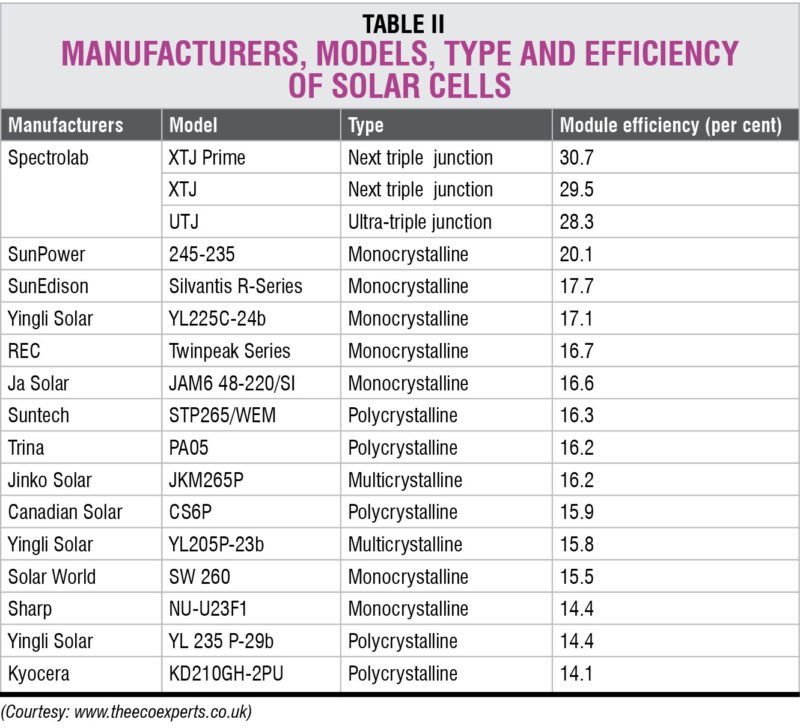
Types of solar cell
Solar cells can be broadly classified as:
Monocrystalline: Made up of a single crystal of silicon
Polycrystalline: Made up of many small crystals of silicon
Amorphous or thin film: Made up of non-crystalline structure of silicon; has four types, namely, CIGS, Cdte, amorphous si and polymer organic
Advantages of solar cells
Main advantages of using solar panels to generate electricity are:
• A solar plant is a renewable power source and is not harmful to the environment.
• It is easy to operate and cost-effective as compared to other renewable power sources.
• It requires less capital investment and low maintenance.
Disadvantages of solar cells
However, there are also some disadvantages such as:
• Solar cells cannot be used in the absence of the Sun.
• Power generated during cloud cover is less.
• A large geographical area is required to deploy solar panels.
Applications
Solar cells are extensively used in calculators and watches. Many people arrange solar panels on the rooftops of their homes or in open areas to generate electric power to operate various devices.
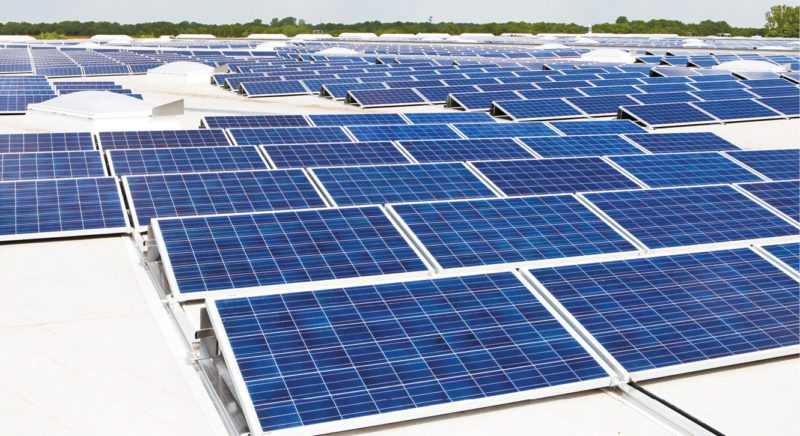
Solar cells are also widely used in Space applications. Researchers have developed multi-junction solar cells especially for spacecraft power systems to increase their power efficiency. Spectrolab, a California based company, is the world’s leading manufacturer of high-efficiency multi-junction Space solar cells and panels, and currently provides power to hundreds of satellites and interplanetary spacecrafts.
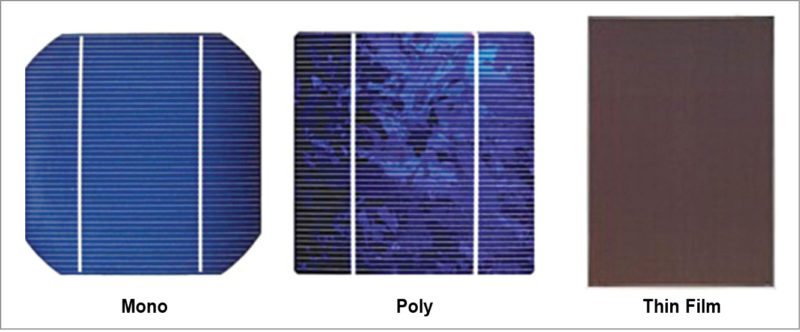
Solar cells are connected in series and parallel to form solar panels that provide more voltage and current. Figs 6 and 7 show solar panels and different types of solar cells, respectively. Table III shows the pros and cons of the different types of solar cells.
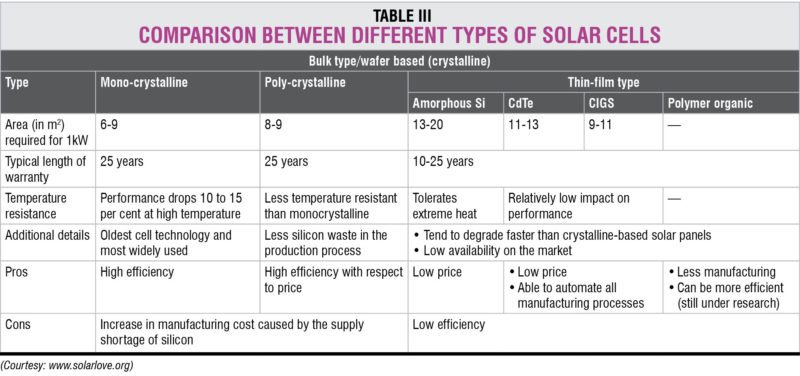
This article was first published on 29 August 2017 and was updated on 18 January 2021.







